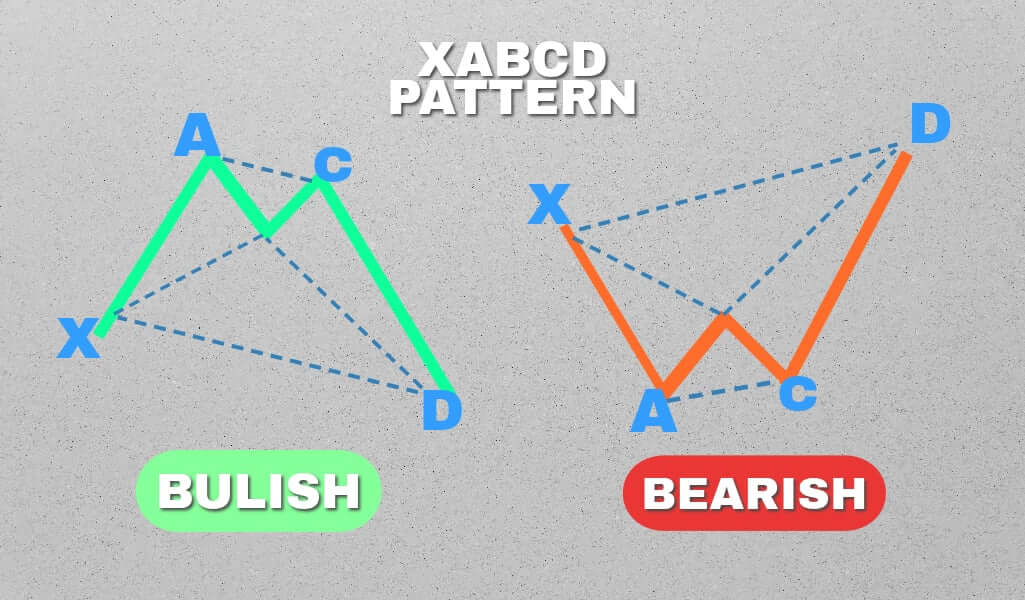
Xabcd pattern: what is it and how to identify it the best
Key Takeaways
- The XABCD pattern is a trading formation that shows when prices are about to change direction. The XABCD pattern is a trading formation that indicates a change in price direction.
- It comprises five points (XABCD) and four segments (XA, AB, BC, and CD). These segments can indicate either an increase or decrease in prices.
- Harmonic trading uses Gartley’s XABCD pattern and Fibonacci levels to analyze markets and identify important formations.
- Three important XABCD patterns are the Gartley, Butterfly, and Bat patterns, each with their own Fibonacci ratios and criteria.
- To identify XABCD patterns, traders can use harmonic scanners or the XABCD indicator, available on platforms like MetaTrader4. Using technology and indicators helps traders spot patterns and trade better in a fast market.
Have you ever heard about the famous Xabcd pattern that numerous traders are buzzing about?
What is crucial about understanding how to trade the Xabcd pattern, anyway? Firstly, we’re discussing a series that came from combining Fibonacci levels.
Harmonic trading, led by Gartley’s XABCD pattern, uses distinctive formations to predict price reversals. These patterns, combined with Fibonacci retracement levels, are vital tools in technical analysis.
How can you recognize and trade the XABCD pattern, covering its structure and practical applications? All that, including spotting reversals using Fibonacci ratios?
Let’s get all the basics about the Xabcd pattern first, shall we?
What is the Xacbd pattern exactly?
The XABCD pattern is a trend reversal formation. Harold McKinley Gartley created this pattern. It comprises five points (XABCD) and four segments (XA, AB, BC, and CD). This pattern can take on a bullish or bearish character, effectively indicating an impending price reversal.
Understanding the XABCD pattern is important as it forms the basis for many other harmonic patterns in technical analysis. Notably, there are three significant XABCD patterns:
- Gartley Pattern: Named after its creator, this pattern embodies distinct structural and Fibonacci ratio characteristics.
- Butterfly Pattern follows the XABCD framework but has Fibonacci ratios and formations.
- Bat Pattern: Similar to Gartley and Butterfly patterns, the Bat pattern has its own Fibonacci ratios and criteria.
They bring unique Fibonacci ratios and criteria.

These patterns follow the XABCD structure, but each has its own Fibonacci ratios and criteria.
Chart patterns have unique characteristics.
These characteristics are important for analyzing price movements and finding potential reversals. They are especially important when using Fibonacci extensions.
What are the three types of Xabcd chart pattern measurements?
An XABCD Pattern encompasses three essential types of measurements:
- Fibonacci Price Measurements
- Fibonacci Time Measurements
- Frequency Wave Analysis.
When we combine these three things, we can analyze a pattern that always stays the same.
Traders can achieve this by examining the pattern from three distinct dimensions:
- Price (along the y-axis)
- Time (along the x-axis)
- Frequency Waves (along the z-axis).
These measurements serve versatile purposes as indicators of potential reversals and indications of trends that keep going.
How to identify the Xabcd pattern the best?
The XABCD pattern is a chart formation used by traders. It helps predict the end of a trend and the start of a new one. It is a powerful tool for traders.
When combined with Fibonacci levels, XABCD patterns are important in technical analysis.
In this article, we explain XABCD harmonic patterns, their different types, and how to use them in forex trading.
What is one of the challenges with other patterns?

One of the challenges associated with Gartley, Bat, Butterfly, and Crab patterns is their intricate identification process.
Earlier, we talked about patterns like the XABCD pattern. They come from Fibonacci principles and have different ratios for each pattern.
This complexity can make it demanding to commit the requisite ratios to memory and fully grasp the information.
How to spot Gartley, Bat, Butterfly or Crab patterns?
To find Gartley, Bat, Butterfly, or Crab patterns, it’s best to use harmonic scanners, but they usually come with a fee.
To find these patterns, you must understand the pattern and use the XABCD indicator. This indicator is available on platforms such as MetaTrader4.
When dealing with a bullish pattern, it takes the form of the letter M, while a bearish XABCD pattern manifests as the letter W.
In the chart below, you can observe the visual representation of a bullish XABCD crab pattern.
Two ways of efficiently Identifying XABCD Patterns
When seeking out XABCD Patterns, keep in mind that you can do it either manually or automatically.
Using Fibonacci tools manually can lead to mistakes due to the complexity of the 12 measurements needed. Utilizing software is a more precise approach, particularly in today’s technologically advanced landscape.
Leveraging Technology for Enhanced Trading
Using technology in trading is good because software can handle lots of data, reducing mistakes.
This streamlines the trading process, making it more efficient and reliable.
Consider the adoption of XABCD Pattern Indicator Suites, which come with a multitude of benefits.
These tools offer impartial analysis of price charts, enabling you to identify potential reversal patterns more accurately.
Continuous pattern monitoring

They monitor patterns in different time frames to help you catch important price changes and reversals.
These indicator suites can reveal hidden patterns that may go unnoticed by humans.
Furthermore, these indicators are instrumental in pinpointing potential reversal zones and confluence areas. This precision improves your trading strategies, helping you make informed decisions in the dynamic trading world.
Key considerations when applying Xabcd patterns
Consider these key points when applying XABCD harmonic patterns based on the earlier information.
- Identify the XABCD formation.
- Utilize the XABCD indicator to outline the five distinct points and four legs – XA, AB, BC, and CD.
- Elevate your analysis by including Fibonacci retracement levels and additional trend reversal indicators like RSI and MACD.
- Once a trend reversal initiates, contemplate starting a position at the D point.
- For Bat and Gartley patterns, institute a stop-loss at the X level as a risk management measure.
Place your take-profit level at or below the A level for all XABCD patterns. This will help you exit successfully in price reversal zones and potential reversal zones (PRZ).
Bottom line
Support and resistance levels represent critical concepts in trading, applicable to both the stock and forex markets. Imagine them as price barriers where price moves face hurdles.
Support levels prevent prices from falling more, while resistance levels stop prices from increasing. These levels often align with significant price swings, which are key turning points in the market.
Traders must understand these dynamics. This understanding helps them gain insights into price reversals. It also helps them make informed trading decisions in stock and forex markets.
The post Xabcd pattern: what is it and how to identify it the best appeared first on FinanceBrokerage.
